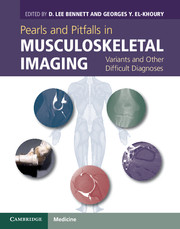Book contents
- Frontmatter
- Contents
- List of contributors
- Foreword
- Preface
- Section 1 Shoulder
- Section 2 Arm
- Section 3 Elbow
- Section 4 Forearm
- Case 29 Pseudocyst of the radial tuberosity
- Case 30 Unstable fracture/dislocations of the forearm
- Case 31 Cat scratch disease: medial epitrochlear lymphadenopathy and pustules of the forearm
- Section 5 Wrist
- Section 6 Hand
- Section 7 Hip and Pelvis
- Section 8 Thigh
- Section 9 Leg
- Section 10 Ankle
- Section 11 Foot
- Section 12 Tumors/Miscellaneous
- Index
- References
Case 30 - Unstable fracture/dislocations of the forearm
from Section 4 - Forearm
Published online by Cambridge University Press: 05 July 2013
- Frontmatter
- Contents
- List of contributors
- Foreword
- Preface
- Section 1 Shoulder
- Section 2 Arm
- Section 3 Elbow
- Section 4 Forearm
- Case 29 Pseudocyst of the radial tuberosity
- Case 30 Unstable fracture/dislocations of the forearm
- Case 31 Cat scratch disease: medial epitrochlear lymphadenopathy and pustules of the forearm
- Section 5 Wrist
- Section 6 Hand
- Section 7 Hip and Pelvis
- Section 8 Thigh
- Section 9 Leg
- Section 10 Ankle
- Section 11 Foot
- Section 12 Tumors/Miscellaneous
- Index
- References
Summary
Imaging description
The more common unstable fracture/dislocations of the forearm are the Essex–Lopresti, Galeazzi, and Monteggia fracture/dislocations. The radiographic findings of an Essex–Lopresti fracture/dislocation are a comminuted radial head fracture coupled with dislocation of the distal radioulnar joint (DRUJ). The Galeazzi injury consists of a radial shaft fracture (usually mid to distal shaft) associated with a DRUJ dislocation. Finally, the Monteggia fracture/dislocation is a group of traumatic injuries having a dislocation of the elbow joint (usually radial head dislocation) associated with a fracture of the ulna at various levels (Figure 30.1).
Importance
These fracture/dislocation injuries are important because they are easily underdiagnosed (most likely due to the fact that they are not common) and need to be treated sooner rather than later with surgical intervention in order to obtain the best clinical outcome. The forearm functions biomechanically like a ring or unit structure, which means that an osseous injury to the radius or ulna that disrupts or alters its length will usually affect the DRUJ or elbow joint leading to an unstable injury. When the DRUJ is dislocated from these injuries it is due to disruption of the triangular fibrocartilage complex caused by sudden shortening of the radial length. When an elbow dislocation is a component of forearm fracture/dislocation injury, it dislocates due to rupture of the annular ligament about the proximal radius.
Information
- Type
- Chapter
- Information
- Pearls and Pitfalls in Musculoskeletal ImagingVariants and Other Difficult Diagnoses, pp. 62 - 63Publisher: Cambridge University PressPrint publication year: 2013
